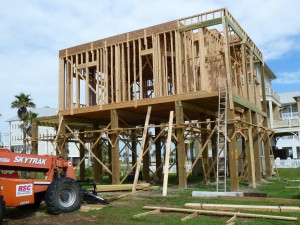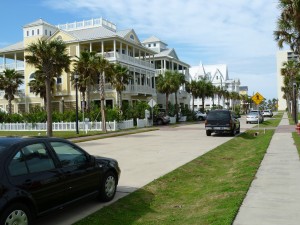 Beachtown is a New Urbanism second-home village in Galveston. Construction began in 2005, after a protracted planning and permitting period. The projected size is about 2,000 houses. Progress has been slow, but then Galveston is hardly a hot development area. Although only fifty miles from Houston, the city never really recovered from a devastating 1900 hurricane. The hurricane, and the Houston Ship Canal, ensured that Houston prospered while Galveston languished. So building a Texas version of Seaside, even when it is planned by Duany & Plater-Zyberk, is a real estate challenge (I saw only a single house under construction). Equally challenging is the requirement that since Beachtown is immediately adjacent to the beach, all habitable space must be raised above the base flood elevation (BFE). Since Hurricane Ike (2008) had a 15-20 foot storm surge, the BFE is high, and the houses are raised about twelve feet above grade on closely spaced timber piles. The
Beachtown is a New Urbanism second-home village in Galveston. Construction began in 2005, after a protracted planning and permitting period. The projected size is about 2,000 houses. Progress has been slow, but then Galveston is hardly a hot development area. Although only fifty miles from Houston, the city never really recovered from a devastating 1900 hurricane. The hurricane, and the Houston Ship Canal, ensured that Houston prospered while Galveston languished. So building a Texas version of Seaside, even when it is planned by Duany & Plater-Zyberk, is a real estate challenge (I saw only a single house under construction). Equally challenging is the requirement that since Beachtown is immediately adjacent to the beach, all habitable space must be raised above the base flood elevation (BFE). Since Hurricane Ike (2008) had a 15-20 foot storm surge, the BFE is high, and the houses are raised about twelve feet above grade on closely spaced timber piles. The  effect is unusual. While the project has all the features one would expect in a DPZ design—interesting plan, sidewalks, thoughtful planting, pathways—the scale is distinctly different. Instead of cottages, the houses resemble Victorian mansions, in part because this is Texas after all and they are very large, and in part because they are in some cases four-stories tall, thanks to the BFE. As you walk down the street you don’t see friendly porches, only driveways and parking bays. Next to Beachtown is a rather incongruous 14-story condominium tower. Or perhaps it’s not so incongruous. If one insists on living next to the water in such a dangerous location—a dubious proposition—one would want to be in a concrete structure high, high above the flood surge.
effect is unusual. While the project has all the features one would expect in a DPZ design—interesting plan, sidewalks, thoughtful planting, pathways—the scale is distinctly different. Instead of cottages, the houses resemble Victorian mansions, in part because this is Texas after all and they are very large, and in part because they are in some cases four-stories tall, thanks to the BFE. As you walk down the street you don’t see friendly porches, only driveways and parking bays. Next to Beachtown is a rather incongruous 14-story condominium tower. Or perhaps it’s not so incongruous. If one insists on living next to the water in such a dangerous location—a dubious proposition—one would want to be in a concrete structure high, high above the flood surge.
On Culture and Architecture
